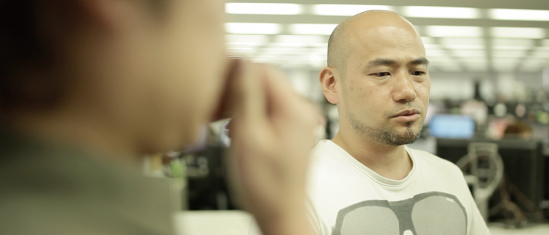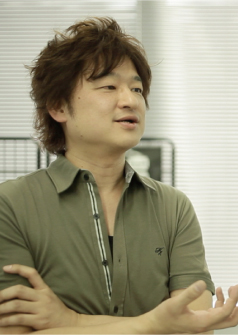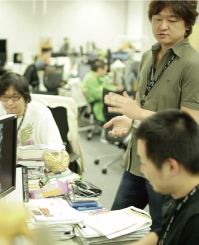(Continues from Part 1.)For the Sake of a Better Game
Inaba: One of the projects I worked on together with Kamiya that I remember particularly well is Viewtiful Joe. He had been a director before for Devil May Cry, but for Joe, I had him do the original game design documents and control the direction of the entire project. I told him, “I want you to work this out alone, without anyone’s help!” In order to give him free reign over the feel of the game world, I oversaw the project as a producer, and kept the team size small.
Kamiya: When I first entered the industry I went right into work on Biohazard. There was already a large team involved, with many experienced staff ready to lend me a hand. But with Viewtiful Joe I was in charge of all the planning and directing from the beginning.
Inaba: I still remember, during the days of Viewtiful Joe and Okami there were times when I thought you had totally lost your way. At one point during the latter half of development, you stopped giving people directions and handed the staff a design document that was basically a blank sheet. I should point out, the way Kamiya makes games is not logical; it starts from a feeling, “This scene looks good.” A director`s job is to fix an overall direction that a game will take, look at what his teams brings him each day, and decide whether it is good or bad. The problem was that there was a while when you weren’t able to make those critical choices. When a director is able to logically oversee a game without any issues, a producer like me can just focus on the people, resources, and capital management needed to deliver a solid product. But back then, I was mostly preoccupied with supporting you and making sure you were able bring things together.
Kamiya: I honestly had no idea what kind of game it would turn into.

Inaba: I still occasionally reflect on the project. It wasn’t a logical game from the very outset. Whereas with Okami it started with you saying “I want to draw nature,” and I was just like, “Wow, that`s cool.”
Kamiya: I put a large emphasis on the quality of graphics in my games; I want the player to feel like they can almost taste the air around them when they are moving through the game world. Unlike the horror games I had worked on in the past, I wanted players to feel good when they saw the vast and beautiful landscape. That was the thought process that gave birth to the idea for Okami.
Inaba: However, the original concept you pitched back then was impossible to realize on consoles at the time. It would probably still be impossible today. About 2 months into the project we realized this and changed the art style accordingly. Originally “Okami” was supposed to be a game in which players could create realistic drawings through gameplay. It became clear this was just not feasible. However, through this process the concept of drawing a 3-dimensional ink painting was born, so I can`t say we were just wasting our time. That said, even though we had the art style in place from quite early on, the all-important game system itself took much longer to come together. I remember getting pretty angry, not just at Kamiya, but at the rest of the team as well.
Kamiya: Unfortunately, no matter how much I get yelled at I can`t come up with ideas I don`t have; I mean, it`s not like I was just fooling around all day. That said, the work we did at Clover Studio felt like the beginning of a large swell of creativity that continues to this day.
Inaba: The title was already announced and was being held up as the first big original game from Clover Studio. The only thing we had at that point was the promotional footage, but man, did it ever look pretty, haha. I`ve mellowed out quite a bit so I can no longer bring myself to get mad at people who are at least in their seat each day trying their best, but back then I didn’t show much compassion, and I was basically just yelling at people all the time.
Kamiya: At the time the team got together and we were all wondering if Okami would end up a failure. There was even some talk of it being cancelled. I responded saying that it would be a tragedy to release the game out into the wild in the state it was in; that`s how rough a state it was in for a while. I would start to shudder just imagining the users trying the game and feeling disappointed…if it was going to come to that I`d rather the game be cancelled.
Inaba: Yeah, and just forget the whole project ever happened. The time and love you put into it won’t be returned; those scars remain. But at least the users are spared. In that sense it can sometimes be better to cancel a game.
Kamiya: It`s true that both Inaba and I have a ton of treasured memories about games, but on the other hand we`ve suffered our share of disappointment at the hands of ill-fated projects. Back when we were kids, games were even more expensive than they are now. If you could get even one game per year you were lucky. Make a mistake and you wanted to scream, “I spent my hard-earned cash on this!?”
Inaba: We still face challenges as a small-staffed studio working on high-spec hardware. There are certainly times when we have to cut various features due to limitations on our end. However, I refuse to let challenges on our side dictate the entire course of production; it is not fair to the player. Instead of using these difficulties as excuses for compromising on quality, we just need to be that much more creative.
Kamiya: I`m not the type to organize all the individual moving parts of a game beforehand, so there are often times when I haven`t worked everything into the schedule. I often come up with good ideas in the middle of production, and the finished product ends up even better than I expected. I know it is a bit risky; I often think, “Man, I really came up with that in the nick of time.” But if that idea will make the game better, you have to do what it takes to get it in there.”
 Inaba: Kamiya`s experience combined with a certain logical backbone are what allow him to see how the parts of a game fit together, but he comes out with the wildest ideas at the 11th hour. “Oh hey, I just came up with something!”
Inaba: Kamiya`s experience combined with a certain logical backbone are what allow him to see how the parts of a game fit together, but he comes out with the wildest ideas at the 11th hour. “Oh hey, I just came up with something!”
We have all come to dread those words. But when it turns out to be a great idea – and as gamers ourselves we all know a good idea when we see one – we just have to pull up our bootstraps and get it done.
Kamiya: It just so happens I was talking about this with a second-year programmer named Hirate today. If we as creators start deciding right off the bat that something is impossible, we will never be able to make anything. Imagine a game designer who is told by his artists and programmers that what he`s asking is impossible. It`s not like he can do those things himself; he`s finished. Good designers and programmers don`t let it end with “impossible.” The type of staff I trust the most are the people who will offer suggestions: “I can`t do that…but what about this?”
I believe that there are many people like that at Platinum. The thing that gets me most annoyed is when people come to me asking for me to okay some decision. I think I`ve broken everyone`s bad habits, but in the past it was rampant. I`d ask them to do something for me, and they`d come back saying “Is this okay?” I`d reply: “Don’t ask me what’s okay, show me what you think is okay!”
Inaba: On the other hand, you’re putting a lot of responsibility on their shoulders like that. But I have to admit that I too, as a producer, most enjoy the moments when someone reports back to me with an idea that exceeds my expectations.
Kamiya: Exactly. As a game fan myself, that joy even rivals that of trying a brand new game. That feeling of excitement takes me back to my experiences as a kid. The games I`ve worked on are filled with ideas that I didn`t come up with, ideas I couldn`t have come up with… in a way that`s what allows me to keep making games I truly enjoy.
(Continues to Part 3.)
interview by editorial studio MUESUM (2012/06/06)